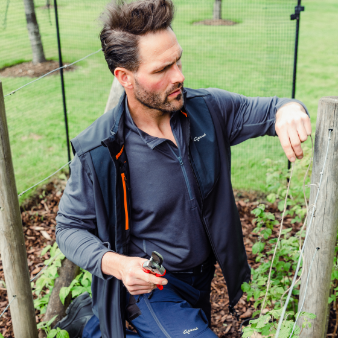Lawn care
With soil temperatures now reliably into double figures, it's a good time to carry out any renovation work on your lawn. Rake out any moss and scatter fresh seed over resultant bare patches. Weed pulling tools do a good job of removing unwanted weeds that have set seed in the lawn but in the absence of one of these, it’s down onto your hands and knees employing your Genus hori-hori knife to dig them out.
Multiply Stock with basal cuttings.
Now is a good time to think about multiplying your stock of perennial plants. It’s always useful to have spare plants to fill unexpected holes or give to visiting friends, something we love doing at Genus. Dahlias, lupins, delphinium, and phlox can all be propagated using basal cuttings, and a good time to do this is when the plant has started to send up new growth 3 or 4 inches high. With a sharp pen knife cut a new shoot off just below the surface of the soil. Dab the cut surface in rooting hormone powder if you like (we don’t bother) and bury the cutting up to half its height in compost - 4 or 5 cuttings to a one litre pot. Water well and very lightly cover with a plastic bag. We cut the corners off to allow some air circulation but still maintain a humid environment for the rootless cutting - you're just trying to create a slightly protected environment but don’t want it to be hermetically sealed and overly damp which can lead to rotting. After 3 or 4 weeks the cutting should show signs of growth - a good sign. After about 10 weeks they can be potted up individually and either planted out in September or kept over winter before planting out in the spring.
Pricking Out
Some of you will have done this already, many haven’t. Pricking out is the process of potting up seedlings sown four or five weeks ago which are now at a manageable size and can be separated out and placed into individual pots. A lollipop stick, plant label, or penknife can be used as a tool to loosen the compost and lift them individually out of the pot. Any handling should be done by holding the leaves, not the delicate stem which can be damaged unwittingly. Transfer these seedlings individually into a 9cm pot of compost making a little hole with our finger before dropping the seedling in and firming the soil around it. Any seedlings that have become a bit long and leggy can be planted deep with much of their stem buried - adventitious roots will be formed along this buried stem creating a stable plant and a more efficient root system. This is especially common with cosmos and tomatoes. Water the pots and put them in a tray ikeeping all the same seedlings together for easy identification later. The ever-important label should then be added.





